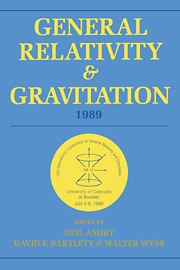 General Relativity and Gravitation, 1989
General Relativity and Gravitation, 1989 Book contents
- Frontmatter
- Contents
- Preface
- Conference committees
- Part A Classical relativity and gravitation theory
- WORKSHOPS
- Part B Relativistic astrophysics, early universe, and classical cosmology
- WORKSHOPS
- Part C Experimental gravitation and gravitational wave detection
- 10 Experimental tests of the universality of free fall and of the inverse square law
- 11 Resonant bar gravitational experiments
- 12 Solar system tests of general relativity: recent results and present plans
- 13 Interferometric gravitational wave detectors
- WORKSHOPS
- Part D Quantum gravity, superstrings, quantum cosmology
- WORKSHOPS
- Part E Overviews-past, present, and future
13 - Interferometric gravitational wave detectors
Published online by Cambridge University Press: 05 March 2012
- Frontmatter
- Contents
- Preface
- Conference committees
- Part A Classical relativity and gravitation theory
- WORKSHOPS
- Part B Relativistic astrophysics, early universe, and classical cosmology
- WORKSHOPS
- Part C Experimental gravitation and gravitational wave detection
- 10 Experimental tests of the universality of free fall and of the inverse square law
- 11 Resonant bar gravitational experiments
- 12 Solar system tests of general relativity: recent results and present plans
- 13 Interferometric gravitational wave detectors
- WORKSHOPS
- Part D Quantum gravity, superstrings, quantum cosmology
- WORKSHOPS
- Part E Overviews-past, present, and future
Summary
It would all be a lot easier (and more satisfying) if one were reporting on the discoveries being made and the new astrophysical information being observed through the gravitational wave channel but unfortunately this can not yet be done. Instead this talk as many others given by workers in this promising but not yet started field has to dwell on the current technical state and prospects. The prospects are now better than ever and one can only hope that in one of the next GR conferences the groups working in this area will be able to talk about the waveforms they are observing and the physics of the sources that are being uncovered.
The active search for gravitational waves from astrophysical sources has been in process for the past two and one half decades. The search began with J. Weber's initial experiments using resonant acoustic bar detectors. These detectors now much improved by advances in transducer technology, better seismic isolation and operation at cryogenic temperatures have attained rms strain sensitivities of h ≈ 10−18 in few Hertz wide bands in the 1 kHz region. More important three such detectors (Stanford, Louisiana State University and CERN/Rome) have made triple and paired coincidence measurements, thereby setting new upper limits on the gravitational wave flux incident on the Earth.
- Type
- Chapter
- Information
- General Relativity and Gravitation, 1989Proceedings of the 12th International Conference on General Relativity and Gravitation, pp. 331 - 340Publisher: Cambridge University PressPrint publication year: 1990


